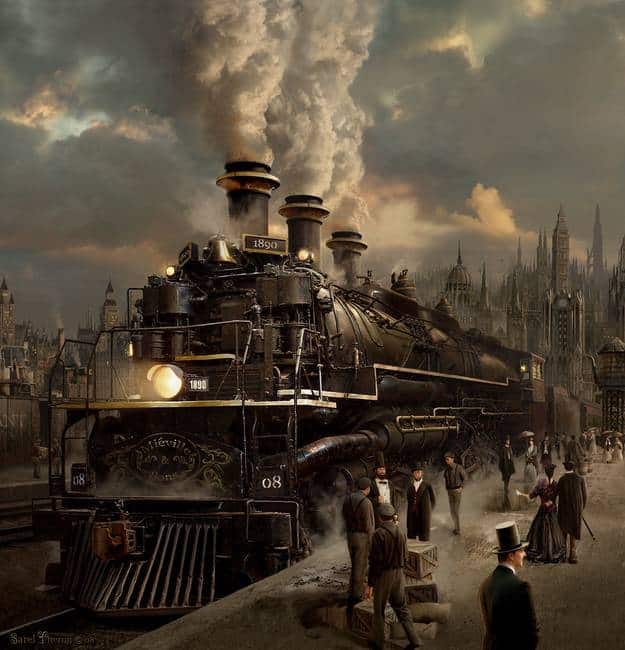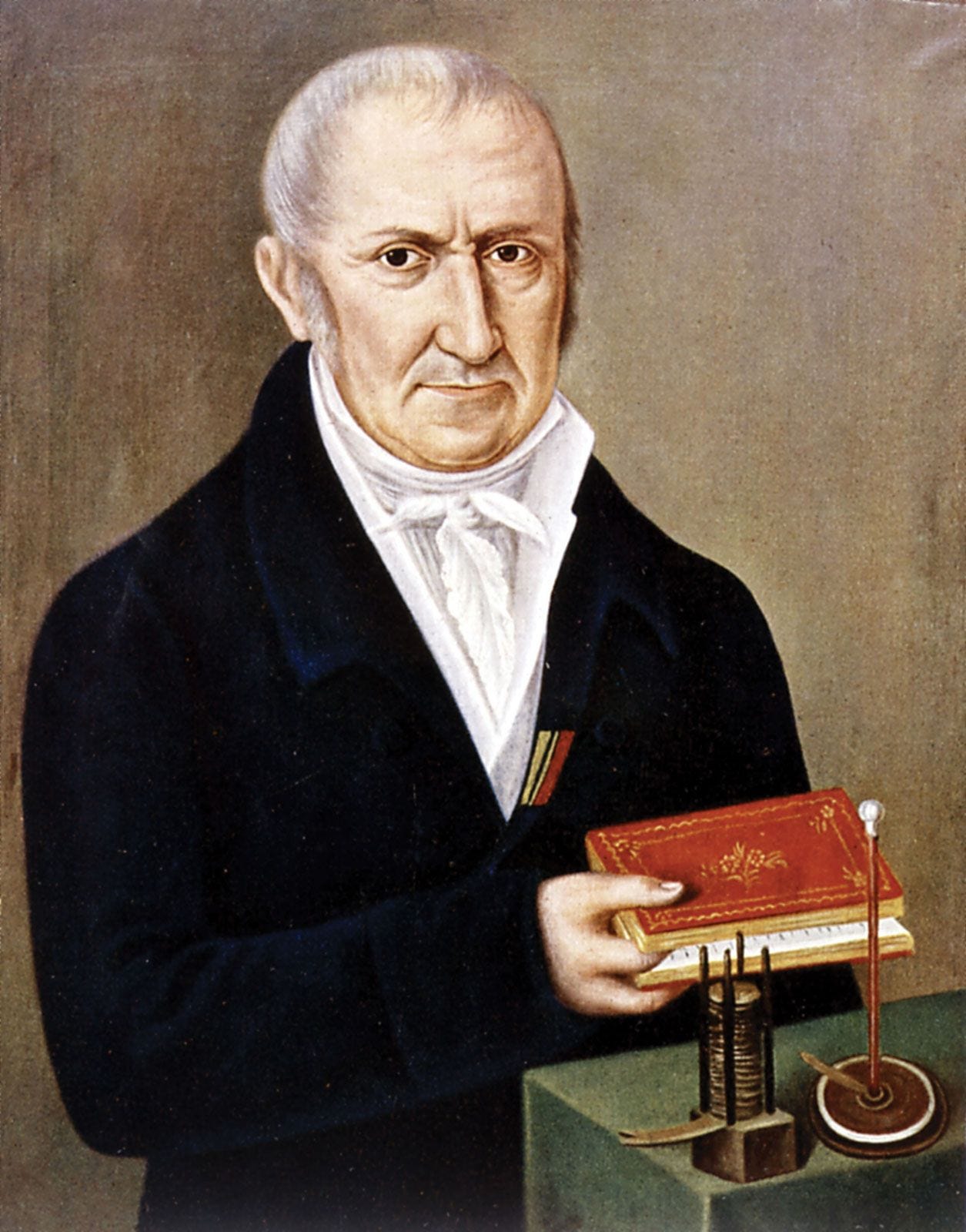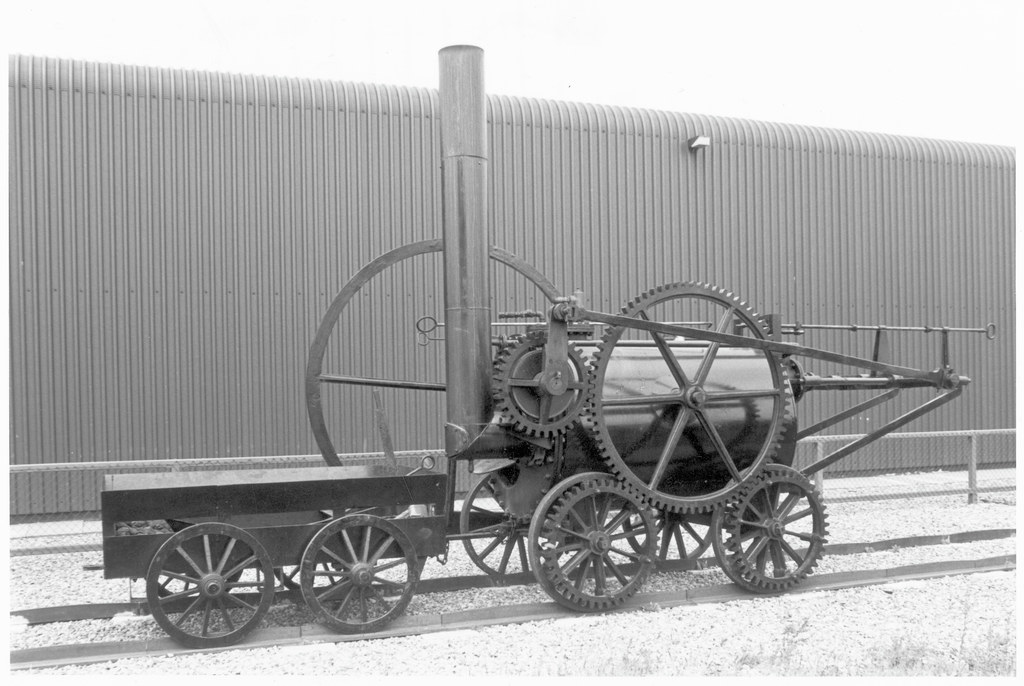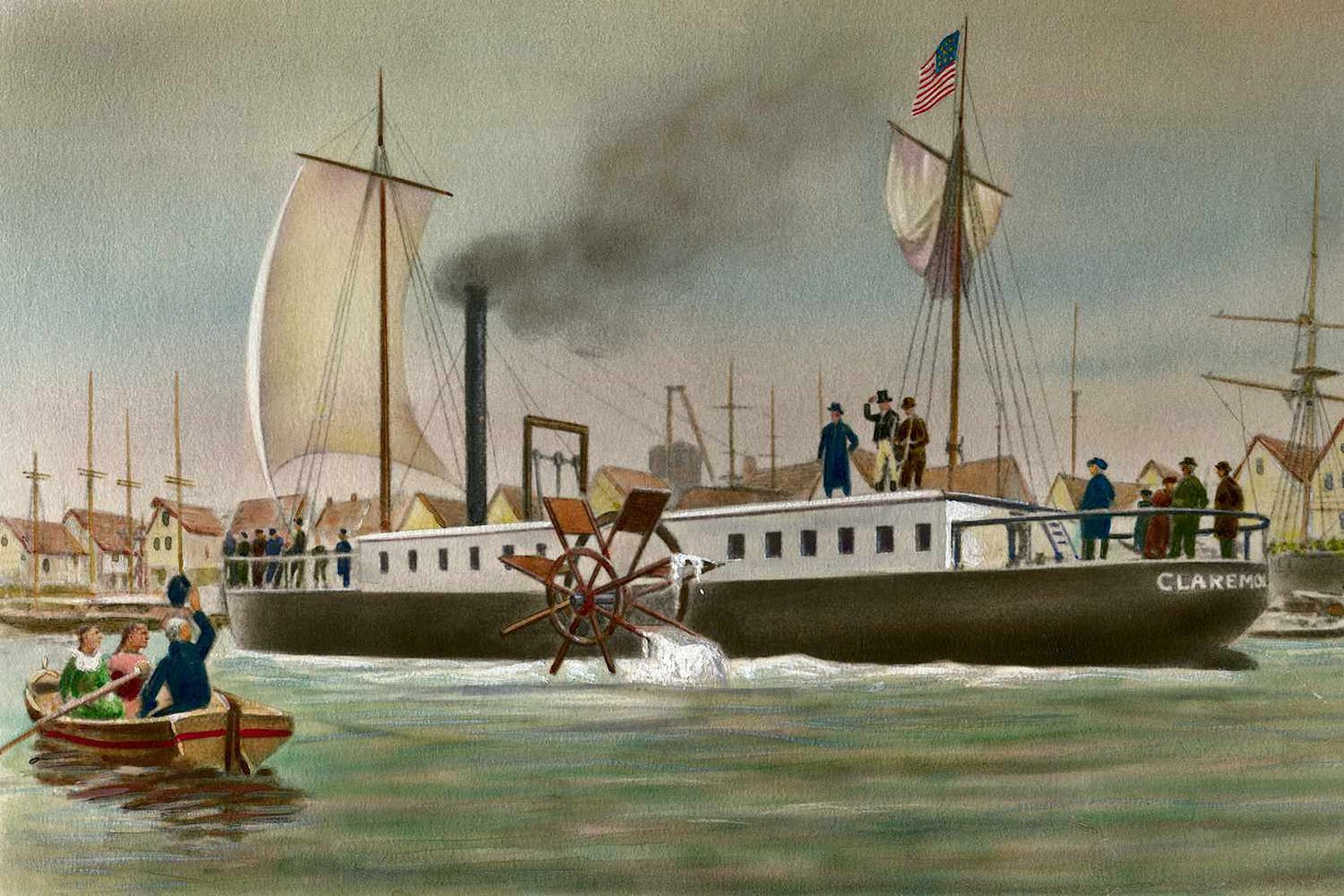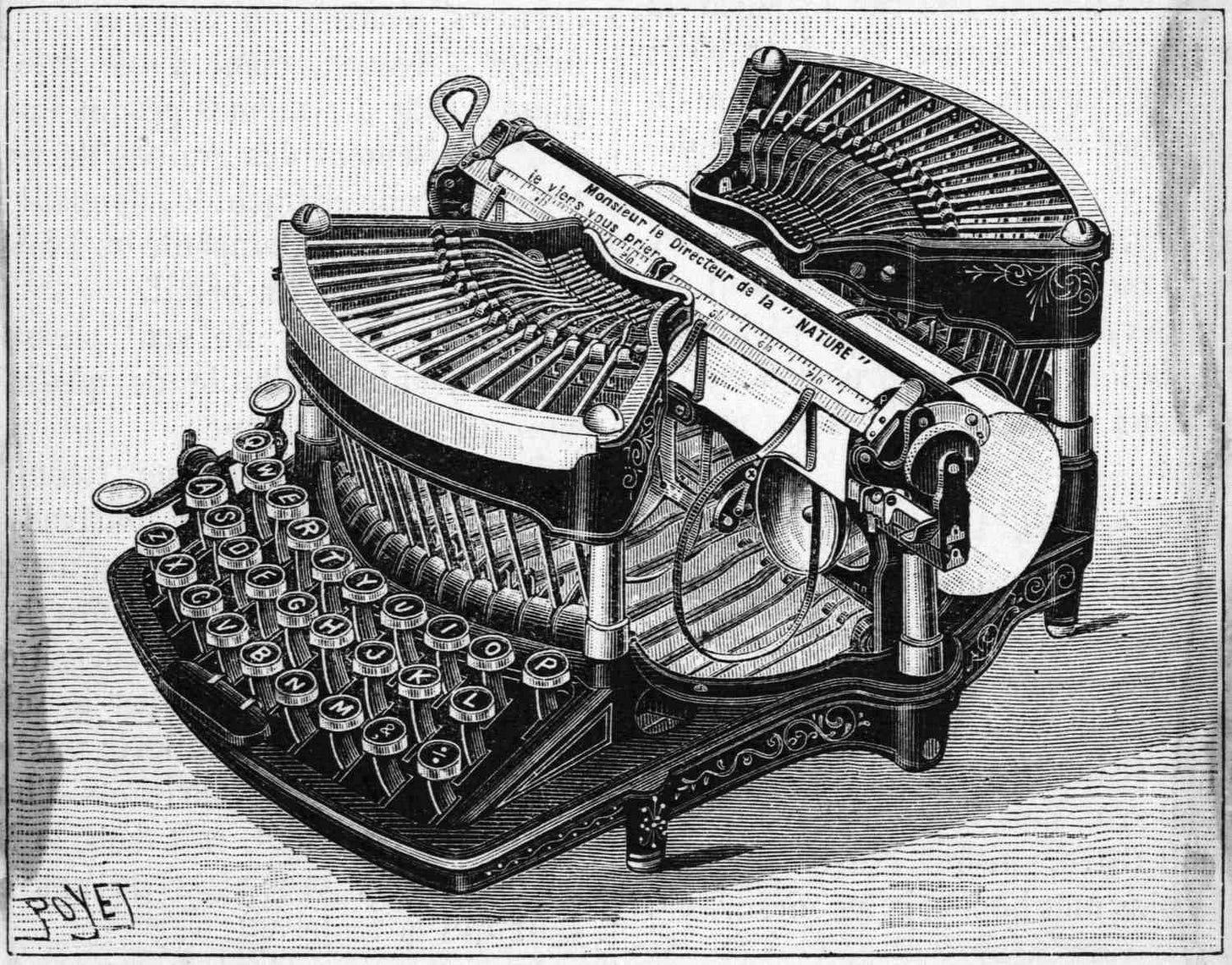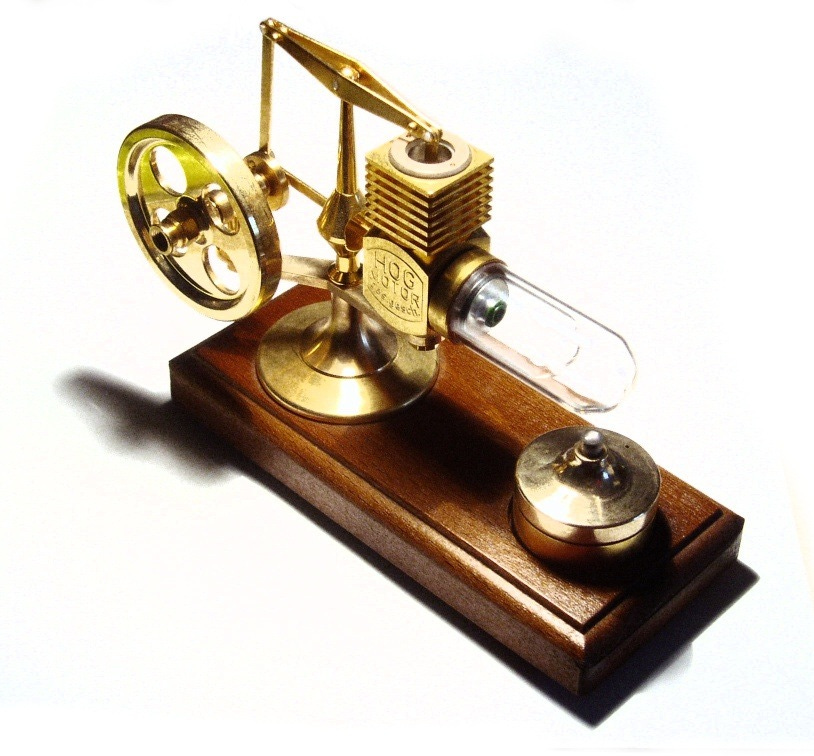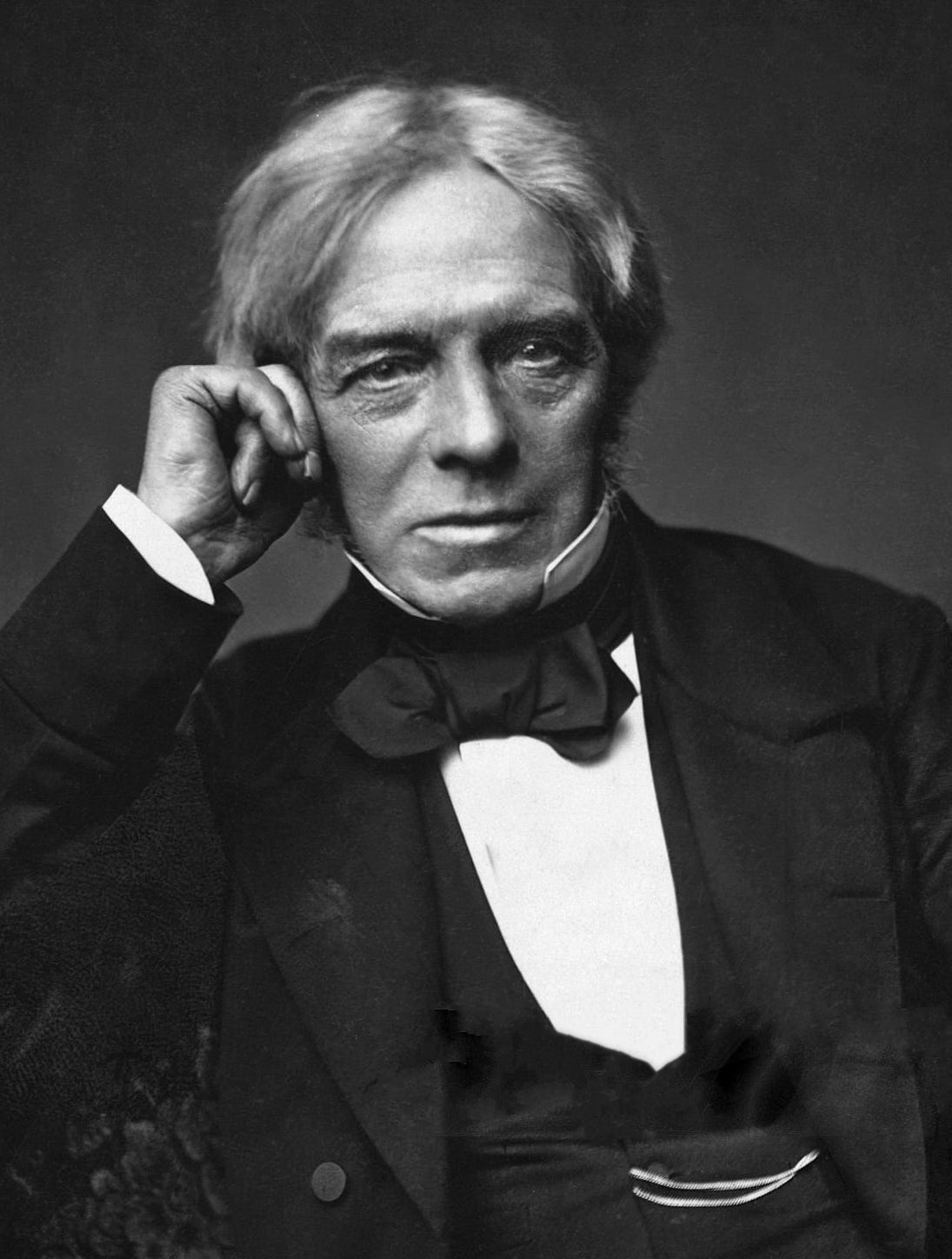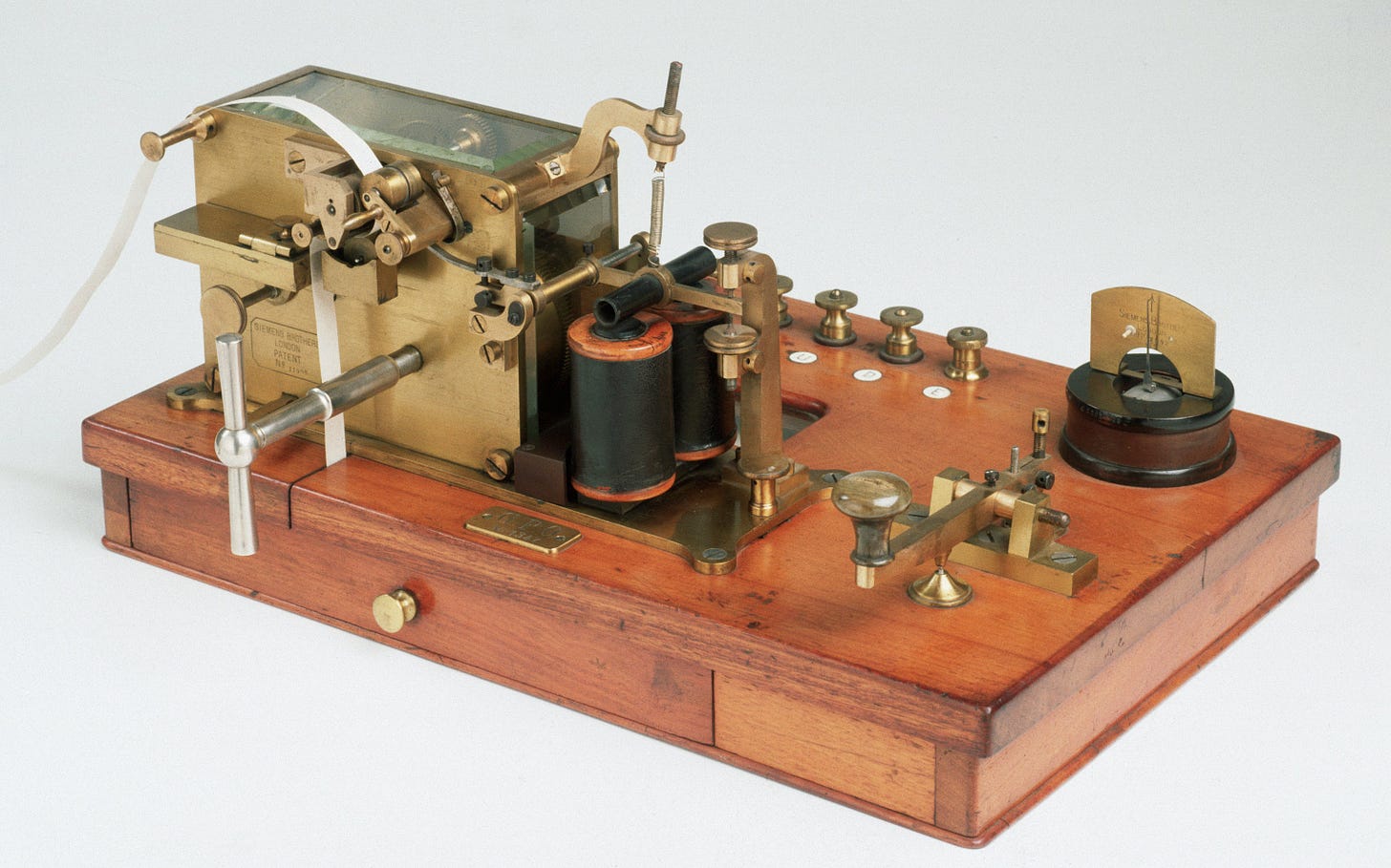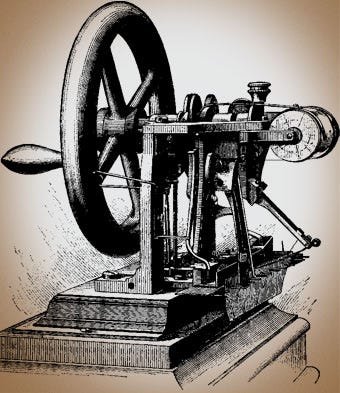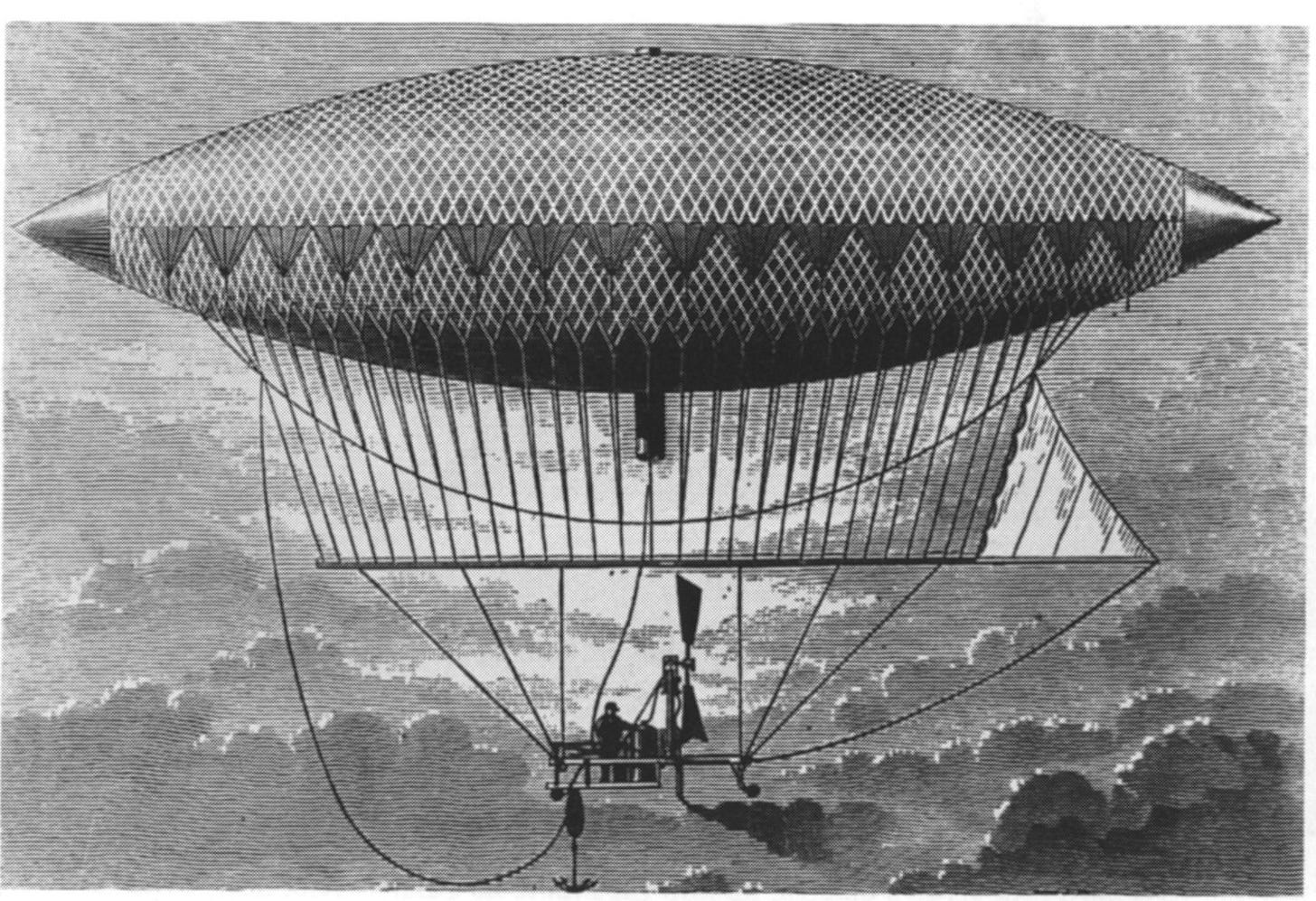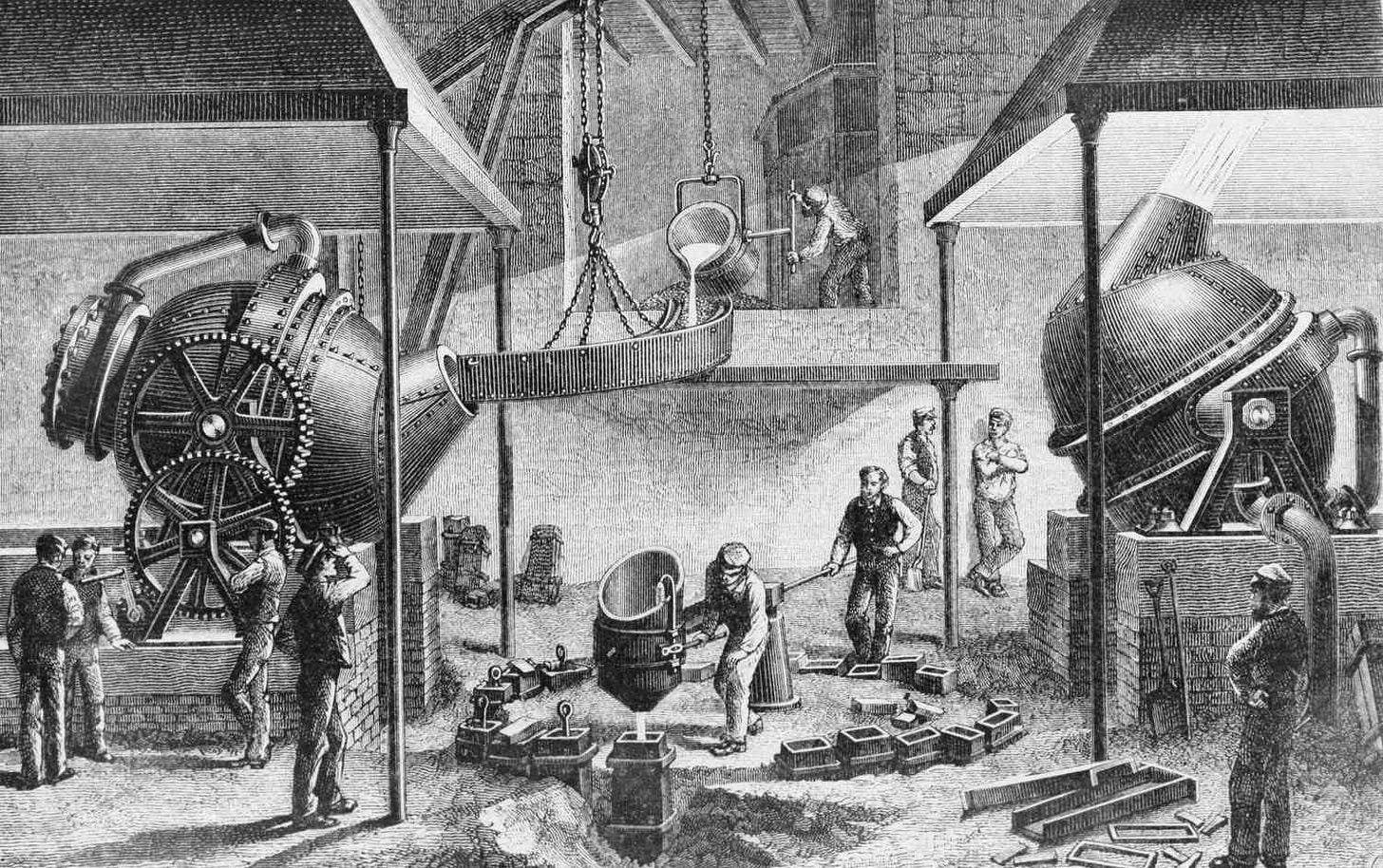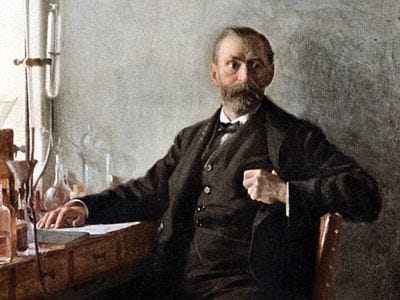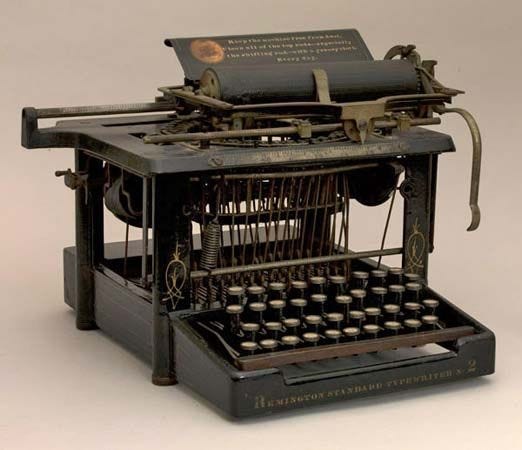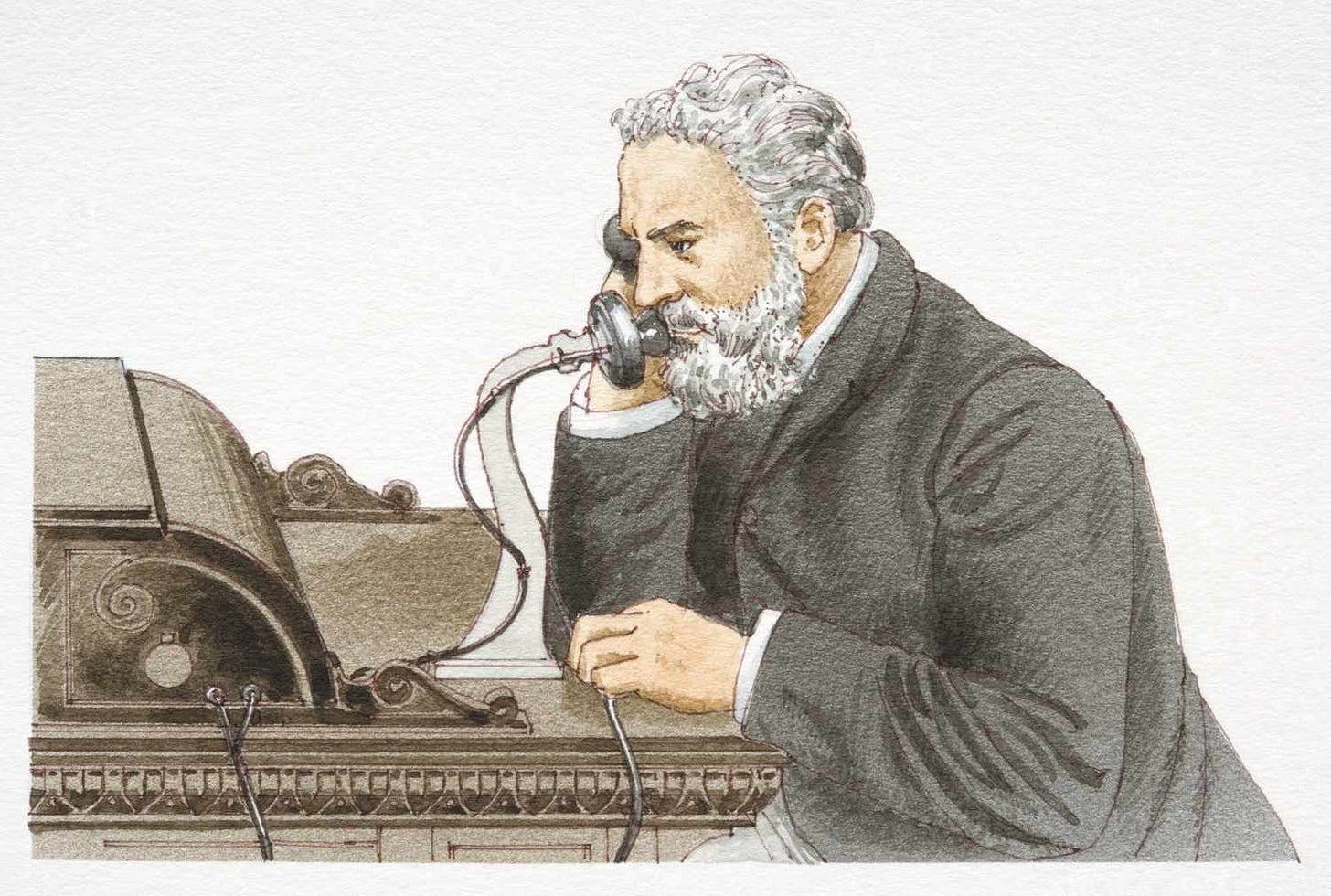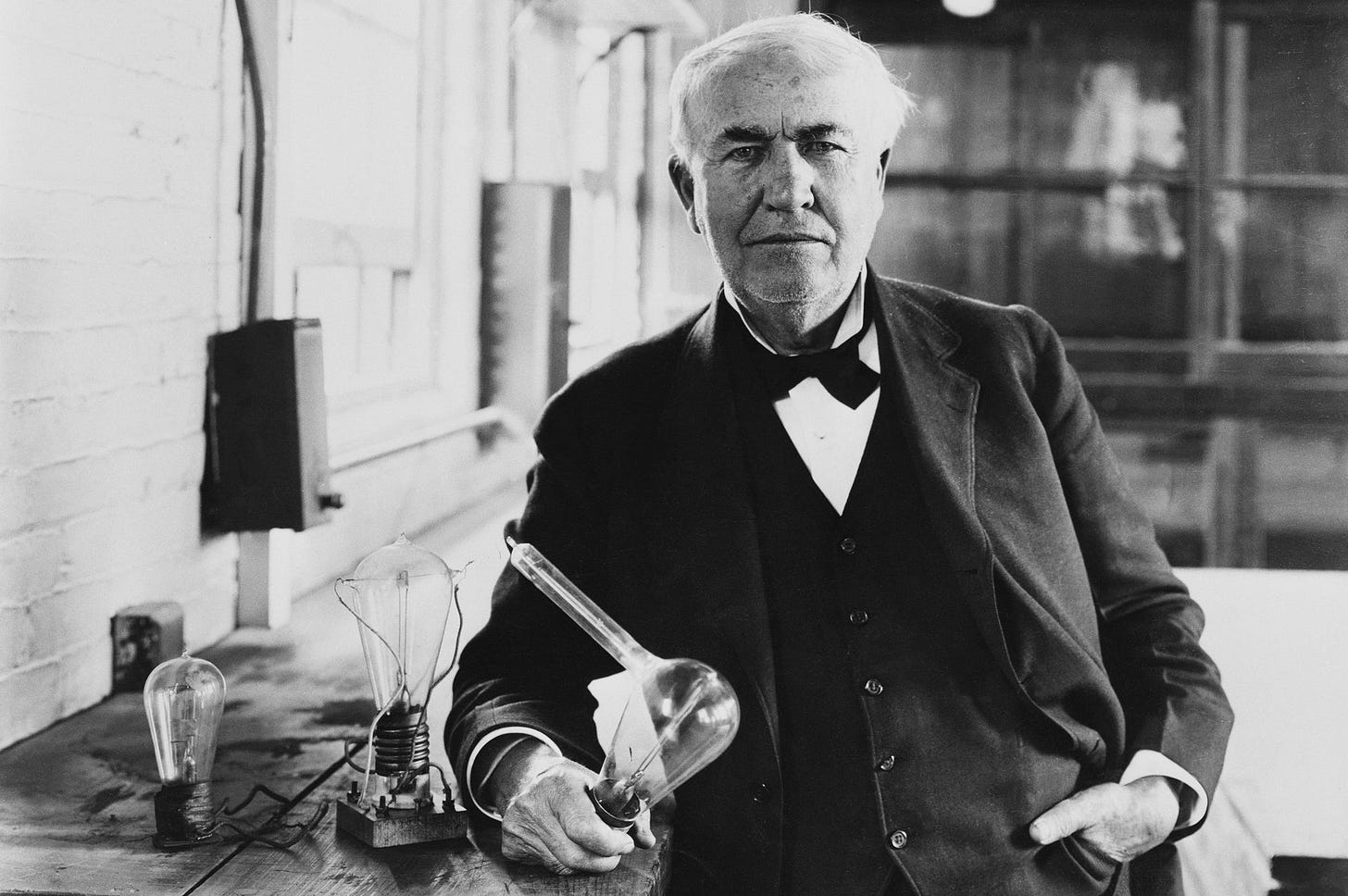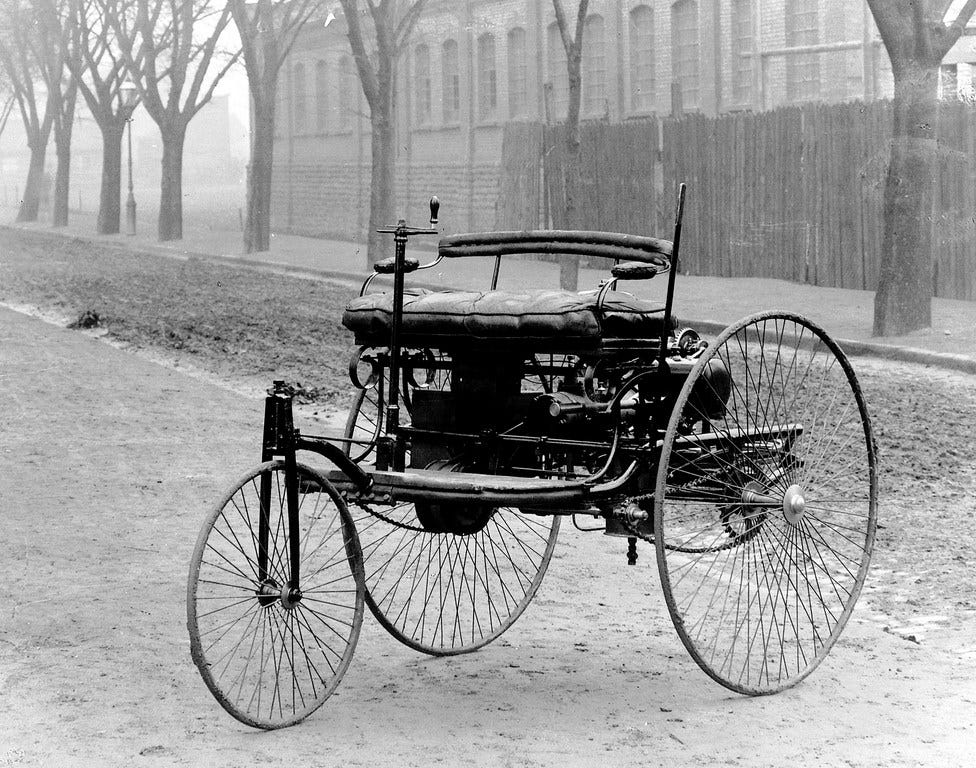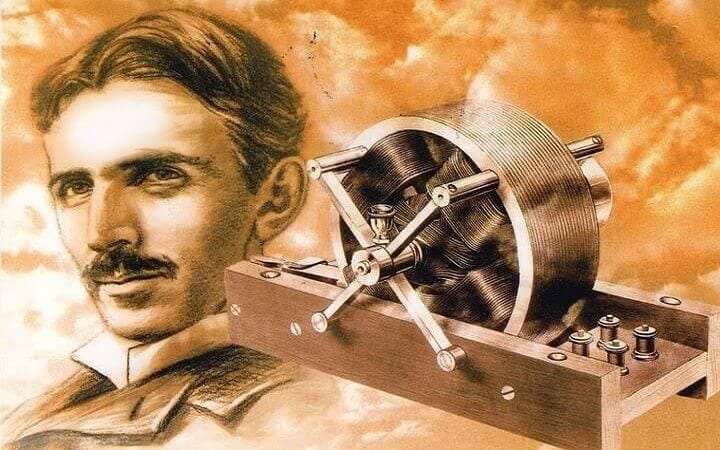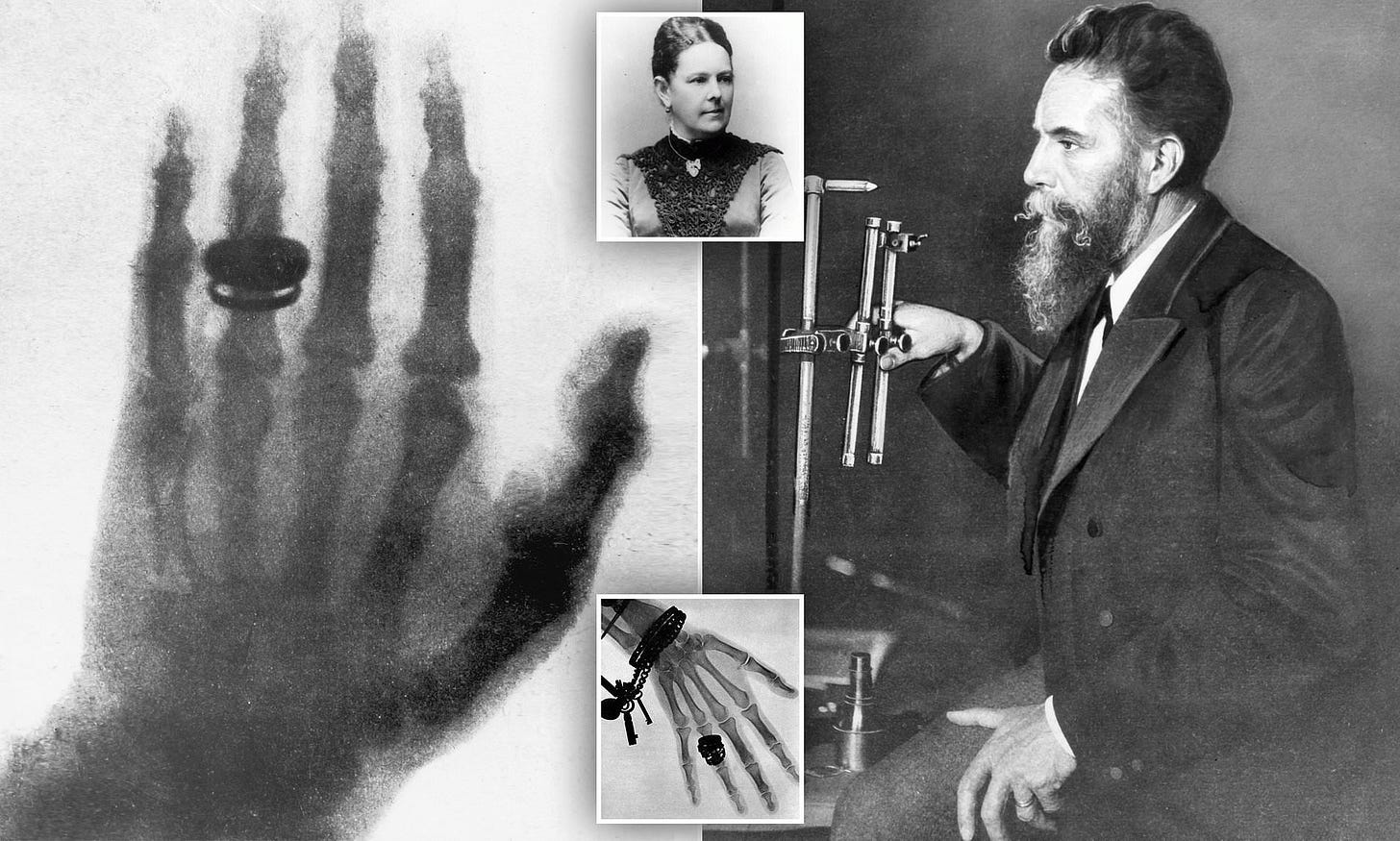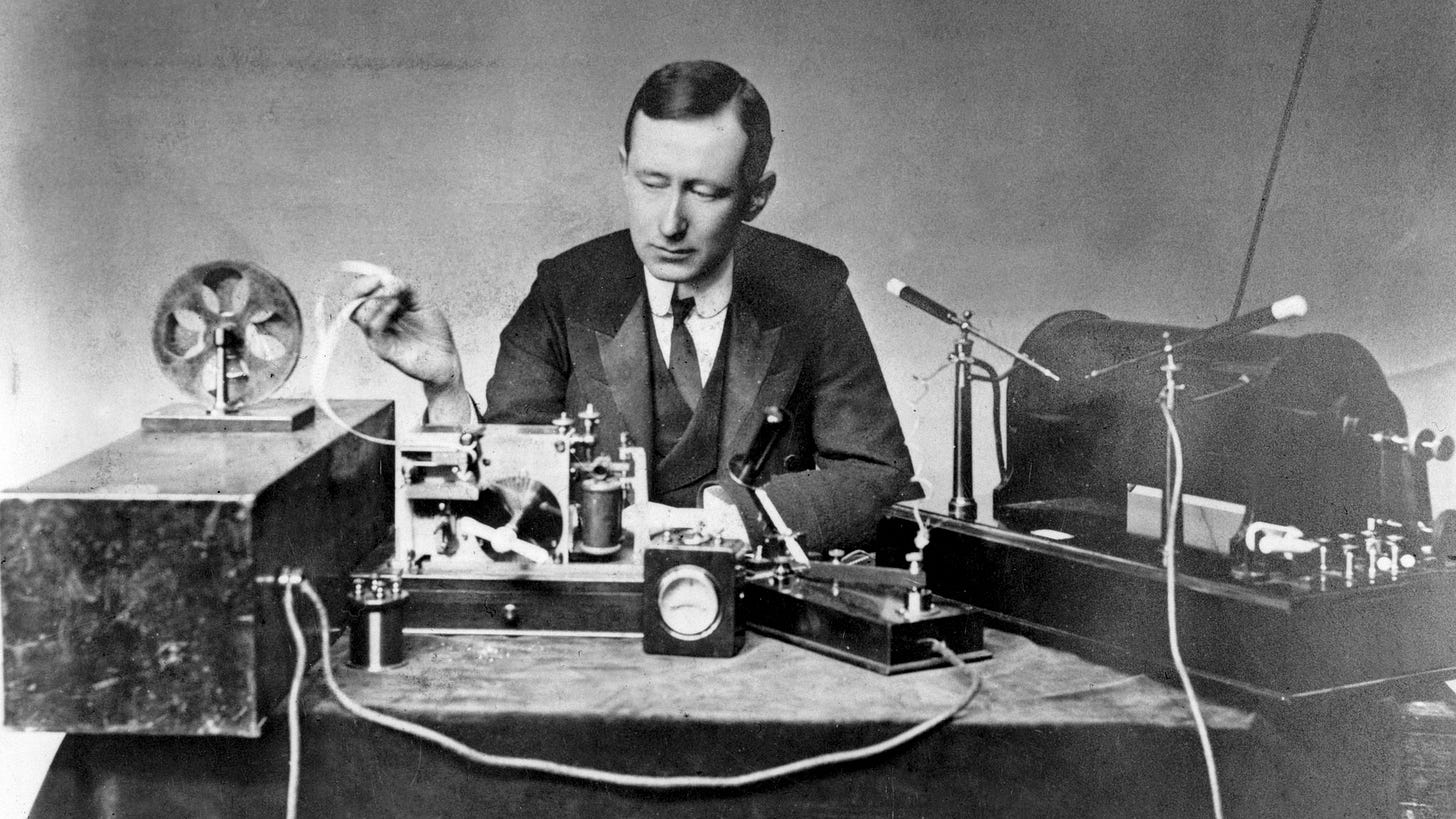Technology and Inventions of the 19th Century
Photography, Lightbulb, Radio, Telephone, Automobile etc...
1.) Timeline
The 19th century was a period of remarkable technological progress and invention. Below is a detailed timeline highlighting some of the key innovations and technological advances of the century:
Early 1800s
1800 - Voltaic Pile: Alessandro Volta invents the first chemical battery, which could produce a steady electric current.
1804 - Steam Locomotive: Richard Trevithick builds the first working railway steam locomotive.
1807 - Fulton's Steamboat: Robert Fulton's "North River Steamboat" travels from New York City to Albany on the Hudson River.
1810s
1814 - Steam Press: George Clymer develops the Columbian printing press, a significant improvement in printing technology.
1816 - Stirling Engine: Robert Stirling patents his heat engine, known for its high efficiency compared to steam engines.
1820s
1826 - Photography: Joseph Nicéphore Niépce takes the first permanent photograph using a camera obscura.
1829 - Locomotive: George Stephenson builds the Rocket, a significant advancement in steam locomotive design.
1830s
1831 - Electromagnetic Induction: Michael Faraday discovers electromagnetic induction, which leads to the invention of the electric generator.
1837 - Morse Code & Telegraph: Samuel Morse invents the telegraph system and Morse code, revolutionizing long-distance communication.
1840s
1842 - Anaesthesia: Crawford Long uses ether for surgical anesthesia, dramatically changing medical surgery.
1846 - Sewing Machine: Elias Howe receives a patent for the sewing machine, significantly impacting the clothing industry.
1850s
1852 - Airship: Henri Giffard constructs the first powered and steerable airship, which used a steam engine.
1855 - Bessemer Process: Henry Bessemer invents the Bessemer process for mass-producing steel, fueling the industrial revolution.
1860s
1866 - Dynamite: Alfred Nobel invents dynamite, an explosive far safer and more powerful than black powder.
1867 - Typewriter: Christopher Latham Sholes develops the QWERTY keyboard layout with the typewriter.
1870s
1876 - Telephone: Alexander Graham Bell invents the telephone, transforming personal and business communication.
1879 - Incandescent Light Bulb: Thomas Edison improves and popularizes the incandescent light bulb, which becomes a commercial success.
1880s
1885 - Automobile: Karl Benz builds and patents the first practical automobile powered by an internal combustion engine.
1888 - AC Motor and Transformer: Nikola Tesla invents the alternating current motor and transformer systems, enabling efficient electrical power transmission.
1890s
1895 - X-rays: Wilhelm Conrad Röntgen discovers X-rays, which revolutionize medical diagnostics.
1898 - Radio: Guglielmo Marconi achieves the first successful transatlantic wireless telegraphy transmission.
2.) Alessandro Volta and the First Chemical Battery
The Voltaic Pile, invented by Alessandro Volta in 1800, was a groundbreaking invention that marked the inception of modern electrical science. This device was the first practical method of generating electricity and was the earliest form of battery capable of continuously providing an electric current to a circuit.
Background
Alessandro Volta, an Italian physicist, was inspired to create the Voltaic Pile after the discovery of animal electricity by Luigi Galvani, who observed that dissected frog's legs twitched when touched by two different metals. Galvani theorized that the tissues housed the animal's innate electricity. Volta, however, believed that the electricity was generated from the contact between the two different metals, not from the animal tissue itself.
Construction of the Voltaic Pile
The Voltaic Pile consisted of a series of copper (Cu) and zinc (Zn) discs stacked alternately. Between each pair of metal discs, there was a piece of cloth or cardboard soaked in saltwater (brine) which acted as the electrolyte. This setup created a simple galvanic cell; when the top and bottom contacts were connected, an electric current flowed through the circuit.
Impact and Applications
The invention of the Voltaic Pile was revolutionary as it provided the first continuous and stable source of electric current. This was unlike static electricity, which provided only brief and strong discharges with no practical use in long-duration applications. Volta's battery fundamentally transformed the study of electromagnetism by enabling experiments that required a steady current.
The Voltaic Pile was the precursor to the development of more sophisticated and efficient batteries. It enabled a host of new scientific experiments and led to further breakthroughs in electromagnetism and electrical technology. Notably, it paved the way for later scientists such as Michael Faraday to experiment with and formulate the principles of electromagnetic induction.
The importance of Volta's invention was recognized universally, and it earned him honors, including a countship from Napoleon Bonaparte. Moreover, the unit of electric potential, the volt, was named in his honor to acknowledge his substantial contributions to electrical science. This invention not only marked a significant milestone in the history of science but also initiated the age of electrical engineering.
3.) The Steam Locomotive and Steam Boat
Richard Trevithick, a British inventor and engineer, developed the first full-scale working railway steam locomotive in 1804. His locomotive, often simply called "Trevithick's Locomotive," marked a pivotal moment in the transportation history.
Key Features and Achievements:
Design: Trevithick's locomotive was built for the Penydarren ironworks in Merthyr Tydfil, Wales. It was designed to pull iron from the ironworks to the nearby Abercynon canal dock.
Technology: The locomotive utilized a high-pressure steam engine, which was an innovative approach at the time. Unlike previous steam engines that used atmospheric pressure and were much larger and less efficient, Trevithick’s design allowed for a smaller and more powerful engine that could generate sufficient power to move the heavy loads.
Historic Journey: On its inaugural trip, Trevithick's locomotive successfully pulled a load of 10 tons of iron, along with 70 men, over a distance of 9 miles (about 14.5 kilometers) from the ironworks to the canal. This journey, despite its challenges such as breaking some of the cast iron rails, demonstrated the potential of steam-powered locomotion on rails.
Fulton's Steamboat
Robert Fulton, an American engineer and inventor, is often credited with developing the first commercially successful steamboat. In 1807, his steamboat, initially named "North River Steamboat" and later known as the "Clermont," made its historic voyage.
Key Features and Achievements
Design: The steamboat was equipped with a paddlewheel and a steam engine that Fulton had developed in partnership with Robert Livingston. The engine was designed by the famous engineer James Watt.
Historic Voyage: On August 17, 1807, Fulton's steamboat left New York City for Albany, a journey covering about 150 miles along the Hudson River. The trip took 32 hours, which was a significant improvement over the sailboats of the time that took nearly a week to make the same journey.
Impact: This successful voyage demonstrated the viability of using steam power for commercial river transportation. It marked the beginning of the steamboat era in the United States, which played a crucial role in the economic expansion of the interior regions along America's rivers.
Both of these inventions—Trevithick's steam locomotive and Fulton's steamboat—were monumental in paving the way for the steam-powered transportation revolution of the 19th century. They not only demonstrated the practical application of steam engines in transportation but also led to significant developments in the industrialization and economic landscapes of their respective regions.
4.) The Steam Press (1814)
In 1814, the steam press represented a significant advancement in printing technology, marking a pivotal development in the mass production of printed materials. This innovation was pioneered by German inventor Friedrich Koenig and his partner Andreas Friedrich Bauer.
Background and Invention
Before the advent of the steam press, printing was done using manual presses, where each page of text had to be pressed individually by hand, a labor-intensive and time-consuming process. Friedrich Koenig, who had been working on improving printing technology, sought to mechanize the printing process to make it faster and less laborious.
Development and Features
Mechanization: Koenig's key innovation was the use of steam power to operate the printing press, which dramatically increased the speed of the printing process. The steam press used a cylinder mechanism, where a cylinder rolled over paper laid on a flat bed of movable type, applying consistent pressure to print much faster than the manual method.
First Public Demonstration: Koenig and Bauer installed their first steam-powered press for the Times newspaper in London. On November 28, 1814, The Times was printed on this new steam press for the first time, producing 1,100 sheets per hour, a remarkable improvement over the 200 sheets per hour possible with previous hand presses.
Impact on Publishing: This increase in productivity made books, newspapers, and pamphlets cheaper and more accessible to the general public, significantly impacting literacy and the spread of information. It also allowed newspapers to cover events more timely due to the quicker turnaround times, influencing public opinion and society more broadly.
Legacy
The steam press is considered one of the key developments in the Industrial Revolution, particularly in the context of the information revolution of the 19th century. It not only revolutionized the printing industry but also had profound implications for society, as it facilitated the rapid dissemination of knowledge and ideas. The technology continued to evolve, setting the stage for further innovations in mass media and communications.
Koenig's steam press laid the groundwork for modern printing technologies and demonstrated how industrial power could be harnessed for complex and precision-oriented tasks like printing, thus changing the dynamics of publishing and contributing to the democratization of information.
5.) The Stirling Engine
The Stirling engine, invented in 1816 by Robert Stirling, is a heat engine that operates by cyclic compression and expansion of air or other gases (the working fluid) at different temperatures, resulting in a net conversion of heat energy to mechanical work. It's a prime example of an early and innovative approach to engine design, using principles of thermodynamics in a novel way.
Background and Invention
Robert Stirling, a Scottish minister and part-time inventor, developed the Stirling engine as an alternative to the steam engines of his time. Steam engines were widely used during the Industrial Revolution, but they were prone to dangerous explosions and were generally inefficient. Stirling's aim was to create a safer and more efficient engine.
Design and Operation
Closed-Cycle Air Engine: The Stirling engine is a closed-cycle (regenerative) heat engine. It contains a fixed amount of gas that is sealed within the engine and never leaves it.
Key Components: The basic components of a Stirling engine include a heat source, a heat sink, a regenerator, and two pistons in separate cylinders—one hot and one cold.
Operating Principle: The engine operates through a four-step cycle involving heating and cooling the gas. The heat source externally heats the gas, causing it to expand and push the hot piston. The gas is then passed through the regenerator (which temporarily stores heat) to the cold piston, where it is cooled and contracts. This contraction pulls the cold piston. The cycle then repeats, continuously converting heat into mechanical motion.
Regenerator: One of the innovative features introduced by Stirling was the regenerator. It improves efficiency by recycling heat that would otherwise be wasted.
Advantages and Applications
Safety and Efficiency: Compared to contemporary steam engines, the Stirling engine was safer (no high-pressure steam) and more efficient.
Applications: While it was initially patented for use as a pumping engine, over time, the versatility of the Stirling engine has allowed it to be used in various applications, including in submarines, yachts, and even experimental power generation setups due to its ability to run on any heat source, including solar and geothermal energy.
Modern Use and Legacy
Despite being overshadowed by the internal combustion engine and steam turbines in commercial and industrial applications, the Stirling engine has seen a revival in niche applications where its main advantages—quiet operation, compatibility with alternative and renewable energy sources, and high efficiency—are significant. It is used in some modern applications like combined heat and power (CHP) systems and in remote power systems where reliability and maintenance are critical.
6.) Photography
The invention of photography in 1826 by Joseph Nicéphore Niépce was a pivotal moment in the visual arts and communication, marking the beginning of a new era in capturing images. This development not only changed how we preserve history and memories but also had profound impacts on art, science, and journalism.
Background
Joseph Nicéphore Niépce was a French inventor who was interested in creating a process to capture the images he saw in a camera obscura—a device that projects an image of its surroundings on a screen. He was motivated by the limitations of the human hand in painting and drawing, which could not fully capture the detail and perspective that camera obscura provided.
The First Photograph
Process: Niépce's earliest successful photograph was created using a process he called heliography, which means "sun drawing." This process involved coating a pewter plate with a bitumen of Judea, a naturally occurring asphalt. The bitumen hardened upon exposure to light, and the unhardened material was then washed away with a mixture of oil of lavender and white petroleum, leaving a permanent image.
First Successful Image: The first successful image, known as "View from the Window at Le Gras," was captured in 1826 or 1827. Niépce set up his camera obscura to overlook the courtyard and buildings of his estate at Saint-Loup-de-Varennes from an upstairs window. The exposure time was extremely long; the camera captured sunlight on different parts of the buildings over a period of several hours, possibly up to eight hours.
Significance and Evolution
Collaboration with Daguerre: Niépce's work laid the foundation for further developments in photography. He eventually formed a partnership with Louis Daguerre, a French artist and photographer, who continued to refine the process after Niépce’s death. This collaboration led to the development of the daguerreotype, a sharper and more practical method that drastically reduced exposure times and produced clearer images.
Impact on Society: Photography revolutionized the way we document events and convey information, contributing to changes in art, science, historical documentation, and journalism. It enabled the capture of precise moments in time and made images more accessible to the public, influencing public perception and memory.
Joseph Nicéphore Niépce’s invention of photography was a monumental achievement that dramatically expanded human capability to record and share visual information, setting the stage for the rich visual culture that defines the modern world.
How cameras Work
Cameras, in their most basic form, function as tools to capture light and record images, either as photographs on film or as digital images on sensors. The core mechanism revolves around controlling how light enters the device and interacts with a sensitive medium to produce an image. Here’s a step-by-step breakdown of how cameras generally work:
Basic Components of a Camera
Body: The main structure that houses all the other components.
Lens: A curved piece of glass or other transparent material that focuses light. The quality, size, and type of lens affect how light is directed and the clarity of the image.
Aperture: A hole within the lens that can adjust its size to control the amount of light entering the camera. The size of the aperture is measured in f-stops.
Shutter: A mechanism that opens and closes to control the duration of light exposure on the film or sensor. The speed of the shutter determines how long the light is allowed to hit the recording medium.
Film or Image Sensor: In film cameras, light-sensitive film captures the image. In digital cameras, an image sensor (like a CCD or CMOS sensor) performs this function, converting light into electronic data.
How a Camera Captures an Image
Light Entry: When you take a photo, light from the environment enters the camera through the lens. The lens focuses this light to form a clear image.
Focusing the Image: The lens adjusts to ensure that the rays of light converge and form a sharp image on the film or sensor. This can be done manually or automatically in modern cameras.
Through the Aperture: As light passes through the lens, it goes through the aperture, which can be widened or narrowed to change the amount of light that reaches the film or sensor. A wider aperture lets in more light (useful in darker conditions) and a smaller aperture less light (helpful in very bright conditions).
Exposure via the Shutter: Once the light has passed through the aperture, it reaches the shutter. When you press the button to take a photo, the shutter opens for a predetermined amount of time (shutter speed), exposing the film or sensor to the focused light, capturing the image.
Capturing the Image:
In film cameras, the light causes a chemical reaction on the film coated with light-sensitive materials, capturing the image.
In digital cameras, the image sensor translates the light into electronic signals, which are then processed to produce digital images. These digital files are stored on a memory card and can be viewed, edited, and shared digitally.
Additional Features
ISO Sensitivity: This is a setting in both film and digital cameras that determines how sensitive the film or sensor is to light. Higher ISO settings are used in darker conditions to capture images without requiring longer exposures, which could lead to motion blur.
Image Processing: In digital cameras, once the image is captured by the sensor, it is processed by an onboard computer. The camera adjusts color, contrast, and other parameters to produce the final image.
Overall, the operation of a camera involves precisely controlling light to create an accurate reproduction of the scene being photographed. This process, whether in film or digital formats, combines optics, mechanics, and, in the case of digital photography, electronics and computer processing to render images.
7.) Electromagnetic Induction
The discovery of electromagnetic induction by Michael Faraday in 1831 is one of the most significant milestones in the field of electricity and magnetism. This principle is the fundamental operating mechanism behind electric generators and transformers, which are crucial to the modern world's electrical power systems.
Background and Discovery
Michael Faraday, a self-taught scientist, was deeply interested in the relationship between electricity and magnetism. His experiments were built upon the earlier observations by Hans Christian Ørsted that an electric current could affect a compass needle, suggesting a link between electricity and magnetism.
The Principle of Electromagnetic Induction
Basic Experiment: Faraday's most famous experiment demonstrating electromagnetic induction involved a coil of wire and a magnet. He found that when he moved the magnet through the coil, an electric current was induced in the wire. Similarly, moving the coil around a stationary magnet also induced a current. This was a groundbreaking discovery because it showed that a moving magnetic field could create an electric current.
Faraday's Law: This phenomenon was later formalized as Faraday's Law of Electromagnetic Induction, which states that a change in magnetic environment of a coil of wire will induce a voltage in the coil. The induced voltage drives a current when the circuit is closed. The law indicates that the induced electromotive force (EMF) in any closed circuit is equal to the rate of change of the magnetic flux through the circuit.
Implications and Applications
Electric Generators: Faraday’s discovery led directly to the development of the electric generator, which converts mechanical energy into electrical energy by rotating a conductor within a magnetic field. This principle remains the basis for all modern electrical power generation, whether it be from wind turbines, hydroelectric plants, or traditional fossil-fuel power stations.
Transformers: Electromagnetic induction is also the principle behind transformers, which can increase or decrease the voltage of alternating current (AC). This allows for efficient transmission of electrical power over long distances and at different voltages, adapting to various needs of power distribution systems.
Impact on Technology and Society
The discovery of electromagnetic induction fundamentally transformed technology and society. It provided the basis for the widespread distribution of electrical power, which is critical for all aspects of modern industrial, commercial, and residential life. Electricity could be generated in one place and transmitted to users miles away, enabling the expansion of cities and industries far from power sources.
Faraday's work on electromagnetic induction not only demonstrated an important natural principle but also set the stage for the electrical revolution that would power the modern world. It underscored the interconnectedness of scientific principles and their potential to drive technological innovation and societal change.
8.) Morse Code and the Telegraph
In 1837, Samuel Morse, an American inventor, and painter, along with his colleague Alfred Vail, developed the telegraph system and Morse code—a breakthrough that dramatically transformed long-distance communication. This invention laid the foundational technology for instant communication over great distances, influencing numerous aspects of society and commerce.
Background and Development
Samuel Morse was inspired to develop a method of rapid long-distance communication after experiencing a personal tragedy where he received delayed news of his wife’s illness and subsequent death. This motivated him to research and develop an electric telegraph system.
The Telegraph System
Mechanism: The telegraph system developed by Morse and Vail was an electrical system capable of transmitting coded messages over wires using electrical signals. It consisted of a sender, a line of electrical wires, and a receiver.
Sender Device: The sender included a key that, when pressed down, would send an electrical signal along a wire. When released, the signal would stop, allowing the operator to encode messages.
Receiver Device: At the other end of the telegraph line, a receiver would interpret these signals. Early versions used a register, a device that marked dots and dashes on a strip of paper, which were later translated into letters and words according to Morse code.
Morse Code
Creation: Morse code, co-developed by Morse and Vail, was a system of encoding textual characters through sequences of dots (short marks) and dashes (longer marks), intended to be simple and efficient to transmit over the telegraph.
Usage: Each letter and number was represented by a unique sequence of dots and dashes. This code was essential because it allowed for the clear, unambiguous transmission of complex messages across telegraph lines.
Impact and Significance
Revolutionizing Communication: The telegraph system allowed for messages to be sent over continents and oceans almost instantaneously, which was revolutionary in the 19th century. It changed the speed of business transactions, news dissemination, and personal communication.
Military and Government Use: During conflicts such as the American Civil War, the telegraph proved crucial for delivering commands and receiving reports from battlefields. It also became an important tool for government administration and diplomacy.
Social Effects: The telegraph system helped in shrinking the perceived size of the world, enhancing the interconnectedness of different regions and cultures.
Foundation for Future Technologies: The telegraph was a precursor to later communications technologies, including the telephone, radio, and the internet. It was part of the wider electrification of communication, influencing how information systems and networks were designed and expanded.
The invention of the telegraph system and Morse code by Samuel Morse not only marked a significant technological advancement but also had a profound impact on the development of modern communication infrastructure and practices. This system paved the way for the rapid global communication network that we rely on today.
9.) Anaesthesia (1842)
In 1842, Crawford Long, an American physician, made a groundbreaking advancement in medical surgery by using ether as a surgical anesthetic for the first time. This innovation marked a significant turning point in medical history, dramatically changing surgical practices by allowing patients to undergo procedures without the pain and distress that were previously considered inevitable.
Background and Discovery
Crawford Long was a physician in Jefferson, Georgia, who observed the effects of ether on people who inhaled it recreationally. Ether was commonly used at "ether frolics," where people would inhale the substance to experience euphoria. Long noticed that individuals under the influence of ether seemed to feel no pain even when they sustained injuries during these gatherings.
The First Use of Ether in Surgery
First Operation: On March 30, 1842, Long used sulfuric ether to anesthetize a patient, James Venable, during a surgical procedure to remove a tumor from his neck. He administered the ether by having Venable inhale it through a towel soaked in the liquid.
Procedure and Outcome: The operation was successful, and Venable reported no pain during the procedure, demonstrating ether's effectiveness as an anesthetic.
Documentation and Recognition: Despite the success of this procedure, Long did not publish his findings immediately. It wasn't until 1849, after other doctors had independently discovered and publicized the use of ether, that Long documented his earlier use in the Southern Medical and Surgical Journal.
Impact on Medicine
Pain-Free Surgery: The use of ether transformed surgical practices by making operations far less traumatic for patients. This development opened the door to more intricate and prolonged surgeries that were not previously feasible due to the pain they would cause.
Wider Acceptance and Use: Following Long's initial use and subsequent independent discoveries and demonstrations by other physicians, such as William T. G. Morton at the Massachusetts General Hospital in Boston, the use of ether spread rapidly across the medical field worldwide.
Ethical and Humanitarian Advances: The introduction of anesthesia addressed significant ethical concerns about the suffering associated with surgery. It led to a more compassionate approach to patient care, fundamentally altering the ethics and humanity of medical practice.
Development of Modern Anesthesiology: The success of ether paved the way for the discovery and development of other anesthetics and the establishment of anesthesiology as a specialized field within medicine.
Legacy
Crawford Long's pioneering use of ether for anesthesia is a landmark event in medical history. It not only alleviated the pain associated with surgery but also significantly reduced the risk and fear surrounding surgical procedures, contributing to the advancement of modern medical practices and improving overall patient care. Long's contributions, while initially overlooked, are now recognized as foundational to the field of anesthesiology.
10.) The Sewing Machine (1846)
The sewing machine, patented by Elias Howe in 1846, represents a monumental advancement in the textile and clothing industry. Howe's invention dramatically improved the efficiency of garment production, setting the stage for the modern clothing industry and significantly influencing both economic and social aspects of society.
Background and Invention
Elias Howe, an American inventor, faced considerable challenges and struggles in developing his sewing machine. Living in poverty and working various jobs, Howe envisioned a machine that could automate the labor-intensive process of sewing by hand.
Key Features of Howe's Sewing Machine
Lockstitch Mechanism: Howe's major innovation was the creation of a practical lockstitch mechanism. This stitch is formed by the interaction of two threads, one carried by a needle on the top side and the other by a shuttle running beneath the fabric. The threads interlock in the middle of the fabric, making the stitch very secure and durable.
Needle with an Eye at the Point: One of Howe's critical design features was placing the eye of the needle at the point rather than at the other end, which was common in hand sewing. This design allowed the needle to carry the thread through the fabric, creating a loop that could be caught by the shuttle to form the lockstitch.
Automatic Feed: The machine featured an automatic feed, which moved the fabric steadily through the machine, allowing for even and consistent stitching, a significant improvement over manual hand sewing.
Patent and Challenges
Howe received a patent for his invention in 1846 but initially struggled to market and sell his machine. He also faced significant legal battles over patent rights, as other inventors such as Isaac Singer began to produce similar machines, often incorporating improvements that made them more practical and commercially viable.
Impact on Industry and Society
Revolutionizing Garment Production: The sewing machine allowed for mass production of clothing. It significantly reduced the time and cost of garment manufacturing, making clothes more affordable and accessible to a wider range of people.
Growth of the Textile Industry: Howe’s invention spurred growth in the textile industry, fostering the development of factories and assembly-line production. This industrialization contributed to urbanization and economic growth.
Employment and Labor Issues: While the sewing machine created new jobs in factories, it also displaced traditional seamstresses and tailors, leading to shifts in labor dynamics and contributing to early industrial labor issues.
Social Impact: By making clothing cheaper and more varied, the sewing machine played a role in changing fashion and social standards. It also had a significant impact on women's lives, both by altering their roles in the workforce and by easing the domestic burden of sewing clothing for their families.
Legacy
Elias Howe's sewing machine laid the groundwork for further innovations in automated sewing and the broader field of mechanization in manufacturing. Despite the initial challenges and competition, Howe's invention remains a landmark in industrial technology, significantly shaping the modern world's approach to garment production and contributing broadly to industrial and social changes in the 19th century.
11.) The First Airship (1852)
In 1852, Henri Giffard, a French engineer and inventor, achieved a significant milestone in aviation history by constructing the first powered and steerable airship. His invention marked a crucial step forward in the development of aerial transportation and demonstrated the potential of lighter-than-air vehicles powered by mechanical means.
Background and Invention
Henri Giffard was driven by the desire to create an aircraft that could be controlled in the air, unlike balloons which largely drifted with the wind. His interest in steam power and engineering led him to explore how these could be applied to flight.
Design and Features of Giffard's Airship
Steam Engine: Giffard's airship was powered by a lightweight steam engine of his own design, which was a remarkable feat given the weight constraints necessary for flight. The engine produced about 3 horsepower and drove a large propeller, enabling propulsion.
Size and Structure: The airship itself was a cigar-shaped balloon, approximately 44 meters (144 feet) long and with a volume of 2,500 cubic meters (88,287 cubic feet) of hydrogen gas, which provided the lift. The envelope was made from cotton cloth coated with varnish to make it airtight.
Steering Capability: Crucially, Giffard incorporated a vertical rudder into the design, allowing him to steer the airship to some extent, although control was still somewhat limited. This was the first instance of a powered air vehicle that could be steered, making it a precursor to modern dirigibles.
First Flight
Giffard’s first and most notable flight took place on September 24, 1852, from the Paris Hippodrome to Elancourt, near Trappes. During this flight, he managed to travel about 27 kilometers (17 miles) from Paris, demonstrating both propulsion and some directional control. Although the wind conditions limited his ability to fully maneuver the airship as he had intended, the flight was a significant success in proving the concept of a powered and steerable airship.
Impact and Legacy
Advancements in Air Travel: Giffard's invention laid foundational concepts for future developments in airship design and aviation. It opened the door to the possibility of controlled air travel and influenced future inventors and engineers in the field of lighter-than-air craft.
Technological Innovation: The use of a steam engine in an aircraft was a pioneering application of existing technology in a new realm, showcasing the versatility and potential of steam power beyond traditional uses such as in trains and ships.
Inspiration for Future Developments: While the practical limitations of steam for aerial propulsion were soon realized—leading to the eventual adoption of internal combustion engines in airships—Giffard’s work inspired others and continued to influence airship design for decades.
12.) Mass Steel Production (1855)
In 1855, Henry Bessemer, an English inventor and engineer, developed the Bessemer process, a revolutionary method for the mass production of steel. This innovation significantly impacted the Industrial Revolution by providing a more efficient, cost-effective way to produce steel, a material essential for modern infrastructure and industrial development.
Background and Development
Henry Bessemer aimed to improve the production of steel, which was then a laborious and expensive process typically done in small quantities. During the Crimean War, Bessemer was motivated by the need for better artillery, which required high-quality steel.
The Bessemer Process
Basic Principle: The Bessemer process involves blowing air through molten iron to rapidly remove impurities and reduce the carbon content, turning iron into steel.
Converter: Bessemer designed a large, pear-shaped receptacle known as a "converter" to facilitate this process. It could hold up to 30 tons of molten iron. The converter was lined with a refractory material to withstand the high temperatures and had openings at the bottom to allow air to be blown through the molten iron.
Operation: Molten iron was poured into the converter, and air was blown through it. The air would react with the carbon in the iron, producing carbon dioxide and heat. This reaction not only purified the iron but also maintained the temperature high enough to keep it in a molten state without additional heating.
Speed and Efficiency: The process could convert molten iron into steel in just 15 to 20 minutes, compared to hours or days with previous methods.
Impact on Industry and Society
Mass Production of Steel: The Bessemer process allowed for the mass production of steel, making it more affordable and accessible. Steel's availability transformed numerous industries, including construction, transportation (railroads and ships), and machinery.
Economic Growth: This method significantly reduced the cost of steel production, contributing to economic growth and the expansion of the Industrial Revolution. It allowed nations to build infrastructure such as railways, bridges, and buildings on an unprecedented scale.
Technological Innovations: The availability of cheap steel also fueled further technological and industrial innovations, including the development of skyscrapers and large-scale engineering projects.
Global Influence: The Bessemer process was quickly adopted worldwide, becoming a standard method for steel production and profoundly affecting global industrial practices.
Legacy
The Bessemer process remained dominant until the early 20th century when it was gradually superseded by the open hearth furnace method, which could produce steel of more consistently high quality. However, the principles of Bessemer’s innovation still underpin modern steelmaking technologies and its impact on industrial capabilities remains a significant chapter in the history of technology. Henry Bessemer's contribution to industrial metallurgy not only revolutionized the production capacities of his time but also laid the groundwork for the modern industrialized world.
13.) Alfred Nobel Invents Dynamite
In 1866, Alfred Nobel, a Swedish chemist, engineer, and inventor, made a significant breakthrough in the field of explosives by inventing dynamite. This invention revolutionized the handling and use of explosives due to its safety and greater explosive power compared to existing alternatives like black powder.
Background and Invention
Alfred Nobel's father was an engineer and inventor who also worked with explosives, providing a background that influenced Nobel's interests and pursuits. Nobel focused on developing a safer, more stable, and powerful explosive. His interest was partly driven by the high risk and instability of nitroglycerin, a potent explosive known for its destructive power but prone to accidental explosions.
The Development of Dynamite
Stabilizing Nitroglycerin: Nobel's key innovation was to stabilize nitroglycerin by absorbing it in a porous material, diatomaceous earth, found in the cell walls of diatoms. This mixture could be shaped into rods, which were then packed into paper tubes.
Safety Features: One of the significant advantages of dynamite over pure nitroglycerin was its stability. Dynamite could be handled much more safely—it was less sensitive to shocks and vibrations, reducing the risk of accidental detonations.
Detonation Mechanism: Nobel also developed a detonator or blasting cap, which could initiate the explosion of dynamite in a controlled manner. This cap was a small metal cylinder filled with a charge that could be ignited by a fuse to set off the main dynamite charge.
Impact and Applications
Construction and Engineering: Dynamite rapidly became an indispensable tool in construction and engineering, facilitating the building of roads, tunnels, canals, and other infrastructures. Its ability to clear large amounts of earth and rock efficiently and safely made these projects feasible on a new scale.
Mining Industry: In the mining industry, dynamite increased the efficiency of extracting resources. It allowed deeper and more extensive mining operations, contributing to industrial growth and economic expansion.
Military Use: While intended for peaceful applications, dynamite also found significant use in military contexts, changing the nature of warfare by providing a more powerful alternative to traditional gunpowder.
Economic and Social Impact: Dynamite reduced costs and accelerated numerous industrial and construction processes. It was a factor in the rapid industrialization of many parts of the world during the late 19th and early 20th centuries.
Legacy
Alfred Nobel's invention of dynamite left a complex legacy. While it contributed enormously to industrial and economic development, its military applications and the potential for misuse caused Nobel personal concern. This led him to leave a significant portion of his wealth to establish the Nobel Prizes, which reward contributions to humanity, including in peace, literature, and the sciences. Nobel's development of dynamite thus not only transformed the technological landscape of his time but also had a lasting impact on cultural and scientific achievements worldwide.
14.) The Typewriter (1867)
In 1867, Christopher Latham Sholes, an American inventor, along with his colleagues Samuel Soule and Carlos Glidden, developed the typewriter, which notably included the QWERTY keyboard layout. This layout and the device itself had a profound impact on writing and communication, significantly influencing business practices, publishing, and personal correspondence.
Development of the Typewriter and QWERTY Layout
Invention Context: Sholes was initially trying to develop a numbering machine to assist with page numbering in books but ended up creating a machine that could type letters instead. This invention was spurred by the increasing demand for efficient communication in the business world and the growing need for faster writing techniques.
Keyboard Layout: The QWERTY layout was designed to solve a mechanical problem; in early designs, frequently used letters placed close together would often jam. By spacing out commonly paired letters, Sholes managed to reduce the jamming. The layout has endured, partly due to familiarity and the training investment of users, even long after the original mechanical reasons for its design became irrelevant.
Patents and Production: Sholes and his partners patented the typewriter in 1868. They entered into an agreement with E. Remington and Sons, a company known for manufacturing sewing machines and firearms, which then started producing the Sholes and Glidden typewriter in 1874.
Impact of the Typewriter
Business and Administration: The typewriter revolutionized business communications. It standardized written documents in terms of readability and format, making paperwork more uniform and professional across industries. It also increased productivity due to its speed compared to handwriting.
Employment and Social Change: The typewriter opened up new employment opportunities, particularly for women. Typing became a skill that was marketed primarily towards women, leading to the rise of the female office worker and shifting societal norms regarding women in the workforce.
Literature and Media: For writers and the media, the typewriter was a tool that allowed for faster writing and editing processes, which facilitated the broader dissemination of literature and news. It enabled writers to be more productive and edit more efficiently.
Education and Training: The widespread adoption of the typewriter spurred the development of typing courses, influencing educational practices and the skills that were deemed necessary for professional success.
Legacy
The typewriter, with its QWERTY layout, is an invention that significantly shaped modern office environments and practices. It laid the groundwork for later developments in word processing and computing interfaces. Today, even though typewriters are largely obsolete, the QWERTY layout continues to be the standard for keyboards around the world, testament to its lasting impact on technology and society.
15.) Alexander Graham Bell and the Telephone ( 1876)
In 1876, Alexander Graham Bell, a Scottish-born inventor, scientist, and teacher of the deaf, invented the telephone, a pivotal technological breakthrough that transformed personal and business communication worldwide. Bell's invention fundamentally changed how information was transmitted, making real-time, long-distance communication practical and accessible.
Background and Invention
Development: Bell was deeply interested in the science of sound due to his family's and his own professional involvement with teaching speech to the deaf. This interest led him to experiment with ways to transmit speech electronically.
Breakthrough: On March 10, 1876, Bell successfully made the first clear transmission of spoken words using the telephone, famously saying to his assistant, Thomas Watson, "Mr. Watson, come here, I want to see you." This experiment demonstrated that sounds could be converted into electrical signals, transmitted via wires, and then converted back into sounds.
Patent: Bell was awarded a patent for the telephone on March 7, 1876, just days before his successful demonstration. The timing of the patent was crucial, as another inventor, Elisha Gray, had independently developed a similar device and filed a caveat on the same day as Bell’s patent application.
Impact of the Telephone
Communication Revolution: The telephone revolutionized communication by making it possible to speak with someone far away almost instantaneously. This marked a dramatic shift from previous forms of communication, such as letters and telegraphs, which involved long delays.
Business and Economy: The telephone had a profound impact on business practices by facilitating real-time communication, coordination, and decision-making across distances. It allowed for the expansion of businesses into wider markets and improved operational efficiencies.
Social Changes: On a social level, the telephone altered everyday life by connecting friends and families across vast distances. It made maintaining relationships easier and reshaped social dynamics by making people more accessible to each other.
Emergency Services and Infrastructure: The telephone also played a critical role in improving public safety and emergency responsiveness. It became an essential tool for coordinating emergency services and was integral to the development of modern emergency response systems.
Global Connectivity: The spread of telephone technology contributed to the globalization of communication, linking different parts of the world more closely than ever before. This connectivity fostered international business and diplomacy, making it easier and quicker to manage international relations.
Legacy
Alexander Graham Bell's telephone paved the way for the development of the global communications network that we rely on today, including the evolution of mobile phones and the internet. The telephone remains one of the most significant inventions in human history, not only because of its immediate practical applications but also because of its lasting impact on the social and economic fabric of societies worldwide. Bell's invention demonstrated the potential of electronic communication, setting the stage for the continual advancements that define our modern digital
Here’s how it works in a step-by-step breakdown:
1. Sound Wave Creation
When you speak into a telephone, your voice produces sound waves. These sound waves are essentially vibrations in the air.
2. Capturing Sound Waves
The telephone handset contains a component called a microphone, which in early telephones was a simple transmitter. This component captures the sound waves. The core of the microphone in early telephones was a diaphragm (a thin piece of material that vibrates when sound waves hit it).
3. Converting Sound to Electrical Signals
Behind the diaphragm, there is a small container filled with carbon granules. When you speak, the diaphragm vibrates and presses on the carbon granules. The pressure changes the resistance of the carbon granules to the electric current flowing through them (more pressure reduces resistance and allows more current to flow). These changes in current flow correspond to the sound wave patterns of your voice. Thus, the variations in sound pressure are converted into corresponding variations in the electrical current.
4. Transmitting the Electrical Signal
The electrical signals are then sent over the telephone line to the receiver at the other end. This signal travels along copper wires (in traditional landlines) or is transmitted as radio waves (in mobile communications).
5. Converting Electrical Signals Back to Sound
At the receiving end, the telephone's speaker (or receiver unit) takes the incoming electrical signals. The receiver also contains a diaphragm, but it works in reverse. Here, the electrical signals cause a magnet to create a magnetic field which moves the diaphragm in the receiver's handset.
6. Sound Wave Recreation
The movement of the diaphragm in the receiver generates sound waves that match the original sound waves at the transmitting end. This allows the listener to hear the speaker's voice reconstructed from the electrical signals.
Summary
In essence, the telephone works by converting the acoustic energy of your voice into electrical energy and then back into acoustic energy. Each part of the process is carefully designed to preserve the quality and characteristics of the original sound. This ingenious use of basic principles of physics and electronics allows us to communicate across vast distances as if we were speaking to someone in the same room.
16.) Thomas Edison and the Lightbulb (1879)
In 1879, Thomas Edison, an American inventor, made significant improvements to the incandescent light bulb, leading to its widespread commercial success and dramatically transforming everyday life by providing a reliable, safe, and convenient source of artificial light.
Background and Early Developments
While Edison is often credited with inventing the light bulb, he was actually one of several inventors working on incandescent lighting. The basic technology—passing an electric current through a resistant material to produce light—had been demonstrated before Edison's involvement. However, these earlier versions were impractical for general use due to short lifespans, high costs, and poor light output.
Edison's Innovations
Durable Filament: Edison's key contribution was finding a material that could emit light for many hours without burning out quickly. After testing over 6,000 substances, he discovered that a carbonized filament of bamboo provided the best balance of longevity and practicality, which later evolved into a carbonized cotton thread filament in his successful models.
Improved Vacuum: Edison improved the vacuum inside the bulb (the space from which air is removed), which helped to prevent the filament from oxidizing and burning out quickly. This improvement extended the life of the bulb significantly.
Electrical System Compatibility: Unlike other inventors, Edison developed an entire integrated system of electrical generation and distribution. His design for the light bulb was specifically intended to be part of this larger system, which made it more practical and appealing for widespread use.
Commercialization and Impact
First Public Demonstration: Edison's first successful public demonstration in Menlo Park, New Jersey, in December 1879, showcased a bulb that could last for 13.5 hours, which later improved to over 1,200 hours.
Formation of Edison Electric Light Company: In 1880, Edison founded the Edison Electric Light Company, which later became General Electric, to manufacture and sell his bulbs and to develop the infrastructure needed to supply electricity to power the bulbs.
Mass Adoption: The introduction of Edison’s light bulb led to the first commercial power station in New York City in 1882, which supplied electricity to a small network of customers. This model was replicated and expanded, leading to broader public access to electric power.
Legacy
The widespread adoption of the incandescent light bulb revolutionized daily life:
Extended Daylight Hours: It extended productive hours beyond daylight, impacting workplaces, homes, and streets with longer operating hours.
Safety and Convenience: It replaced gas lamps, which were prone to fires and required more complex infrastructure, with a safer and more convenient option.
Cultural and Social Shifts: The ability to light spaces easily and cheaply changed social habits and living conditions, impacting everything from the workday to leisure time and public safety.
Edison's work on the incandescent light bulb not only marked a milestone in the application of electricity but also catalyzed further developments in electrical engineering and technology, contributing profoundly to modern industrial society.
Here’s a straightforward explanation of how a traditional incandescent light bulb works:
Electricity Supply: When you turn on a light switch, electricity starts flowing through the circuit and into the light bulb.
Filament Heating: Inside the light bulb, there is a thin wire called a filament, usually made of tungsten. Electricity flows through this filament, which is resistant to the electric current.
Heat Generation: As the electric current struggles to pass through the resistant filament, the energy transforms into heat. This is due to the resistance converting electrical energy into thermal energy.
Light Emission: The filament gets so hot that it glows, emitting light. This process is called incandescence, which is the emission of light from a hot object.
Containment within a Bulb: The glowing filament is enclosed in a glass bulb, which is either vacuum-sealed or filled with an inert gas like argon. This environment prevents the filament from burning out quickly by protecting it from oxygen in the air.
So, in simple terms, a light bulb lights up because electricity heats a thin wire in it until it glows. The glow is the light we see, and the glass bulb around the wire keeps the wire glowing longer by protecting it from the air.
17.) Karl Benz and the First Automobile (1885)
In 1885, Karl Benz, a German engineer and inventor, achieved a significant milestone in the history of transportation by building and patenting the first practical automobile powered by an internal combustion engine. This invention laid the foundation for the modern automotive industry and dramatically transformed how people moved around the world.
Background and Development
Karl Benz was motivated by the desire to create a vehicle that could move without the need for rails or horse power. His background in engineering and his interest in gasoline engines fueled his pursuit of this goal. Before Benz's breakthrough, various experiments with steam and electric vehicles had taken place, but none had resulted in a practical, marketable road vehicle.
The Motorwagen
Design and Features: Benz's vehicle, later known as the Benz Patent-Motorwagen, was a three-wheeled vehicle with a rear-mounted single-cylinder engine. The engine produced approximately 0.75 horsepower, which was enough to propel the vehicle at speeds up to 10 miles per hour.
Innovations: The Motorwagen included several innovative features that were critical to its functionality:
Gasoline-powered engine: The engine was a four-stroke internal combustion type, which was a relatively new technology at the time.
Ignition system: Benz designed an electrical ignition system, which was crucial for starting the engine reliably.
Gear system: The vehicle had a simple transmission system to control speed.
Chassis and layout: The layout of the vehicle, with a steel-tube frame and a rear-mounted engine, influenced future automobile designs.
Patent and Commercial Success
Patenting the Invention: Karl Benz patented his invention in 1886, securing his place as the inventor of the first practical automobile. The patent covered not just the engine but the entire concept of a gas-powered vehicle.
Public Reaction and Adoption: The initial public reaction was mixed, with skepticism about the safety and practicality of replacing horses with motorized vehicles. However, over time, as improvements were made and more demonstrations were conducted, the public began to see the potential of the automobile.
Manufacturing and Sales: Benz founded Benz & Cie. in 1883, which became the world's largest automobile company at the beginning of the 20th century. The Motorwagen began to be commercially produced and sold, paving the way for mass production techniques that would later be perfected by others like Henry Ford.
Legacy
Karl Benz's invention of the Motorwagen marked the beginning of the automotive era. It not only demonstrated the viability of using internal combustion engines for personal transportation but also inspired further innovations and developments in the automotive industry. The basic principles established by Benz—such as the gasoline-powered internal combustion engine and the configuration of the vehicle—remain foundational to the design and function of modern automobiles.
18.) Nikola Tesla and AC Power (1888)
In 1888, Nikola Tesla, a Serbian-American inventor, engineer, and physicist, made significant contributions to electrical engineering with his development of the alternating current (AC) motor and transformer systems. These inventions were pivotal in the adoption of alternating current for long-distance electrical power transmission, which proved to be a more efficient and practical method compared to direct current (DC) systems prevalent at the time.
Development of AC Motor and Transformer
AC Motor: Tesla's invention of the AC induction motor was groundbreaking. This type of motor operates on alternating current, which generates a rotating magnetic field that induces a current in the motor's rotor. This process results in mechanical motion. The AC motor was notable for its simplicity, efficiency, and the fact that it required no commutator, a complex part used in DC motors that frequently wore out and needed maintenance.
Transformer Systems: Alongside the motor, Tesla developed transformer systems capable of efficiently stepping up (increasing) or stepping down (decreasing) the voltage of an alternating current. High voltages could be used for long-distance power transmission, minimizing energy loss over large distances, and then the voltage could be reduced safely for consumer use.
Impact and Implementation
Efficiency in Power Transmission: Tesla's innovations allowed for the efficient transmission of electricity over long distances. By using transformers to increase the voltage for transmission and decrease it for end-user applications, the system minimized power loss and made electrical power widely and economically available.
War of Currents: Tesla's work set the stage for the "War of Currents," a well-known struggle between Tesla (and his business partner George Westinghouse) and Thomas Edison, who was a staunch proponent of direct current. Edison's DC systems were less efficient over long distances due to the higher energy losses and the limitations on the distance the electricity could be transmitted.
Demonstration and Adoption: Tesla and Westinghouse demonstrated the safety and effectiveness of AC at the Chicago World's Fair in 1893, powering the entire fair and demonstrating AC’s superiority over DC. This led to the adoption of AC for the creation of the first major hydroelectric power plant at Niagara Falls.
Legacy
Nikola Tesla's inventions of the AC motor and transformer systems are considered some of the most important contributions to modern electrical engineering. The principles of his work are still the basis for modern electrical power systems. The ability to efficiently distribute electrical power transformed urban development, industry, and many aspects of daily life, ushering in an era of rapid technological advancement and economic growth.
Tesla’s vision and technical innovations not only solved practical problems of his time but also laid the groundwork for future technologies, including everything from household appliances to the modern electric grid. His legacy persists in the electrical standards, devices, and large-scale power distribution systems we use today.
19.) The X-Ray (1895)
In 1895, Wilhelm Conrad Röntgen, a German physicist, made a groundbreaking discovery that would revolutionize medical diagnostics and many scientific fields: X-rays. This discovery not only transformed medical practices by allowing the inside of the human body to be seen without surgery, but it also opened new avenues in physics and chemistry.
Discovery of X-rays
Accidental Discovery: Röntgen discovered X-rays accidentally while experimenting with cathode rays, which are streams of electrons observed in vacuum tubes. On November 8, 1895, while testing whether cathode rays could pass through glass, he noticed a glow coming from a nearby chemically coated screen. This glow persisted despite the cathode ray tube being covered, indicating it was caused by something unknown, which he initially called "X-rays" for their unknown nature.
First X-ray Photograph: Röntgen's experiments continued, and he soon took the first X-ray photographs, famously capturing the image of the bones in his wife's hand. This image astonished the world when he presented it because it clearly showed her bones and her wedding ring, while her flesh was rendered invisible in the image.
Impact of X-rays
Medical Diagnostics: The immediate and most notable impact of X-rays was in medicine. For the first time, doctors could look inside a patient's body without invasive surgery to diagnose fractures, blockages, and other internal disorders. This capability fundamentally changed diagnostic procedures and treatments.
Scientific Research: X-rays became a crucial tool in scientific research, allowing scientists to study the internal structure of objects and materials without damaging them. This had implications not only in physics but also in fields like chemistry and biology.
Industrial and Security Applications: Beyond medicine and science, X-rays found applications in industrial quality control and security. They are used to inspect welds, castings, and baggage at airports for hidden objects.
Radiation Awareness: The discovery of X-rays also spurred research into radiation and its effects on biological tissues, leading to the development of safety measures and radiation protection standards.
Legacy
Wilhelm Conrad Röntgen’s discovery of X-rays earned him the first Nobel Prize in Physics in 1901. The discovery's implications were vast and led directly to the development of the field of radiology, which specializes in imaging techniques used for medical diagnosis and treatments. X-rays also paved the way for further discoveries, such as the development of computed tomography (CT) and the exploration of the atomic and molecular structure of materials.
Today, X-rays remain a fundamental tool in hospitals and clinics worldwide, essential for a broad range of diagnostic and therapeutic procedures, underscoring their lasting impact on modern medicine and science.
X-rays are a form of electromagnetic radiation, similar to visible light, but with much higher energy and shorter wavelengths. This high energy allows X-rays to pass through objects that light cannot, such as the human body, which makes them extremely useful for medical imaging and other applications.
How X-rays Work
X-rays are generated when high-speed electrons strike a metal target. This happens in an X-ray tube, a device that is key to generating X-rays:
Electron Production: Inside the X-ray tube, an electron gun, which is essentially a heated filament, releases electrons when heated (a process called thermionic emission).
Acceleration and Collision: These electrons are then accelerated by a high voltage towards a metal target (typically tungsten). When these high-speed electrons hit the tungsten target, their sudden deceleration produces X-rays.
Emission of X-rays: The energy from the electrons converts into X-rays, a process that involves the interaction of the electrons with the atoms of the metal target.
Harnessing X-rays
Once generated, X-rays can be directed towards the object to be imaged, such as a part of the human body in medical diagnostics. Here’s how they are typically harnessed:
Direction and Focus: In an X-ray machine, the rays are focused and directed towards the target area. Lead or other materials that X-rays cannot easily pass through are used to shape and direct the beam to the specific area that needs imaging.
Passing through Materials: As X-rays pass through the body, they are absorbed at different rates. Bones, which are denser than soft tissues, absorb more X-rays and thus appear lighter on the X-ray image.
Detection: After passing through the body, the X-rays hit a detector (like photographic film or digital detectors), which captures the varying amounts of X-rays that have passed through different tissues, creating an image.
Viewing X-rays
The final image created by the X-rays is called a radiograph or more commonly, an X-ray image. This image can be viewed on film or on digital screens, depending on the technology used in the X-ray system:
Film Radiography: Traditional X-ray images are developed on photographic film, similar to how photographs are developed.
Digital Radiography: Modern systems often use digital detectors that convert X-rays into electrical signals, which are then processed by computers to produce images on the monitor. This method allows for immediate viewing and manipulation of images.
20.) The Radio (1898)
In 1898, Guglielmo Marconi, an Italian inventor, achieved a significant milestone in communication technology by successfully transmitting wireless telegraphy signals over the Atlantic Ocean. This accomplishment marked the first practical demonstration of long-distance wireless communication and laid the foundational technology for modern radio.
Development and Early Experiments
Background: Marconi's interest in wireless communication began in the early 1890s after learning about the electromagnetic wave theory proposed by Heinrich Hertz. Inspired to turn these theoretical insights into a practical communication tool, Marconi started experimenting with wireless telegraphy in Italy.
Initial Innovations: Marconi made several key innovations, including improving the range and reliability of wireless signals. He developed a more effective transmitter and used a coherer (a device for detecting radio waves) as a receiver, which was crucial for early radio telegraph systems.
The Transatlantic Transmission
Challenge: The idea of transmitting signals across the Atlantic was met with skepticism from many in the scientific community, who believed that the curvature of the Earth would limit the effective range of electromagnetic waves.
Achievement: In December 1901, Marconi disproved the skeptics by successfully transmitting the letter "S" in Morse code from Poldhu, Cornwall, in the United Kingdom to St. John's, Newfoundland in Canada—over a distance of about 2,100 miles (3,400 kilometers).
Technical Aspects: This historic transmission utilized a massive kite-supported antenna for reception. The successful reception of the signal was a combination of using high-altitude antennas and Marconi’s powerful spark-gap transmitter, which could produce strong radio waves.
Impact and Legacy
Communication Revolution: Marconi's successful transatlantic transmission demonstrated the viability of wireless communication over long distances, revolutionizing the way messages were sent and received. It paved the way for the development of modern radio, which soon became essential for both personal and commercial use, including broadcasting, navigation, and later, mass media communication.
Commercial Exploitation: Following this success, Marconi established the Marconi Wireless Telegraph Company, which built high-powered radio transmission stations across the British Empire and beyond, securing his technology's position as a vital communication tool.
Global Connectivity: The technology fundamentally changed global communications, enabling instantaneous communication across oceans and continents without the need for physical connections like cables, which were susceptible to damage and required expensive maintenance.
Nobel Prize: In 1909, Marconi was awarded the Nobel Prize in Physics (shared with Karl Braun) for his contributions to the development of wireless telegraphy.
Marconi's work not only initiated the era of wireless communication but also laid the groundwork for all subsequent radio technology, influencing the development of other technologies that rely on the transmission of electromagnetic waves, such as television and cellular phones. His pioneering work is a cornerstone in the history of communication, underlining how a single technological leap can have wide-reaching effects on global connectivity and information exchange.
Radio Waves
Creation of Radio Waves: At the broadcasting station, sounds (like music or someone speaking) are converted into electrical signals. These electrical signals are used to modulate (alter) a radio wave, which is a type of electromagnetic wave. This modulation can vary the amplitude (height) or frequency (spacing) of the wave to encode the sounds being sent.
Transmission of Radio Waves: These modulated radio waves are then sent out through the air from a tall antenna at the radio station. The antenna sends these waves out in all directions.
Traveling of Waves: The radio waves travel through the air at the speed of light, covering vast distances. They can pass through various objects and materials, which is why we can receive radio signals indoors and in cars.
Reception of Radio Waves: Your radio has an antenna that picks up these waves from the air. Different stations transmit on different frequency waves, and your radio can tune into these different frequencies. This is what you are doing when you adjust the dial or press a button to change stations.
Decoding the Signals: Once your radio captures these radio waves, it decodes them back into electrical signals that resemble the original signals sent from the station. It does this by filtering out the wave itself and keeping the changes (modulation) that were applied to the wave.
Sound Production: Finally, these electrical signals are sent to the speakers in your radio, which convert them back into sound waves. These are the sounds you hear—your favorite songs, news, or chat shows.
Here’s why radio waves travel at the speed of light:
Nature of Electromagnetic Waves: Electromagnetic waves, including radio waves, are created by the movement of electrically charged particles. These waves consist of electric and magnetic fields that oscillate perpendicular to each other and to the direction of wave propagation.
No Need for a Medium: Unlike sound waves, which require a medium (like air or water) to travel, electromagnetic waves do not need a medium. They can travel through the vacuum of space where there is no matter. This inherent property allows them to maintain their speed without being hindered by interactions with atoms and molecules, which is why they reach the maximum speed at which any information can travel — the speed of light.
Fundamental Constants: The speed of light is not just a high velocity; it's a fundamental constant of the universe, denoted as "c" in physics equations. The properties of vacuum and the constants of electric and magnetic fields in free space dictate this speed.

